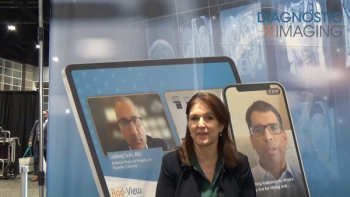
Content-driven PACS may guide future diagnoses
Efforts to interconnect information systems raise the possibility that different experiences from multiple sites might be pooled and the practice of medicine made better through a kind of collective wisdom. At the ISCT symposium, Sandy Napel, Ph.D., a Stanford professor of radiology and codirector of the Radiology 3D Laboratory, examined how diagnoses made on some patients might help clarify whether the same diagnoses apply to others.
Efforts to interconnect information systems raise the possibility that different experiences from multiple sites might be pooled and the practice of medicine made better through a kind of collective wisdom. At the ISCT symposium, Sandy Napel, Ph.D., a Stanford professor of radiology and codirector of the Radiology 3D Laboratory, examined how diagnoses made on some patients might help clarify whether the same diagnoses apply to others.
Napel proposed identifying possibly helpful images through interpretations made by radiologists and information contained in the pixels themselves.
“It’s been known for many years that good information is contained in images and coded into the semantics of interpretations, information that might allow pattern-based classification,” he said. “The bottom line here will be whether particular patterns suggest particular diagnoses.”
Napel and colleagues illustrated this potential with liver lesions seen on CT, performing a pilot study to determine whether such pixel-based and semantic features could be used to retrieve similar images of lesions seen in other scans. In a peer-reviewed paper scheduled to appear soon in Radiology, the team will report looking at 79 portal venous phase liver CTs from 44 patients. The images included 25 cysts, 14 hemangiomas, 24 metastases, six hepatocellular carcinomas, three abscesses, evidence in five of focal nodular hyperplasia, one fat deposit, and one laceration.
Napel concluded that combinations of computer-derived and semantic features can be used to retrieve similar images. He noted, however, that if multiple databases are used, challenges regarding common terms could arise. For example, the same lesion might be called “hypodense” by some interpreters and “nonenhancing” by others. Less susceptible are computer-derived features found in images, such as the shape, texture, or edge of lesions. Results might be further refined by searching images constructed in 3D, multiple vascular phases, or using multiple energies.
Ultimately this capability may be part of PACS 2.0, the next generation of PACS, which employs advanced image analysis tools. Decision-supported PACS might allow radiologists to query databases not only by interpretation or pixel-based parameters such as shape, but also by molecular data that can link imaging phenotype to genomics and genotype. Such a system may even go beyond diagnoses, Nepal said, to provide information about the success rates of specific treatments on specific types of patients.
“Content-based retrieval could be just the beginning of helping us get to where we would like to go (with personalized medicine),” he said.
Newsletter
Stay at the forefront of radiology with the Diagnostic Imaging newsletter, delivering the latest news, clinical insights, and imaging advancements for today’s radiologists.




























